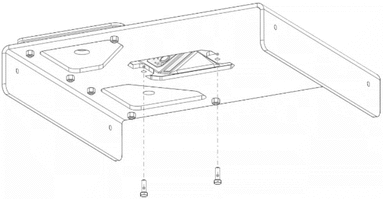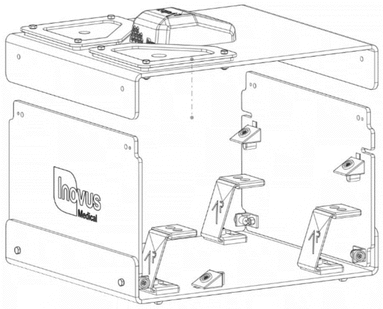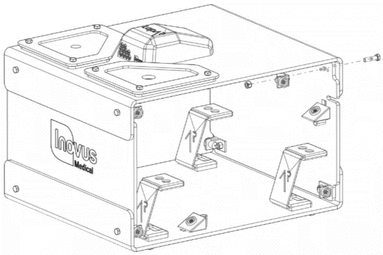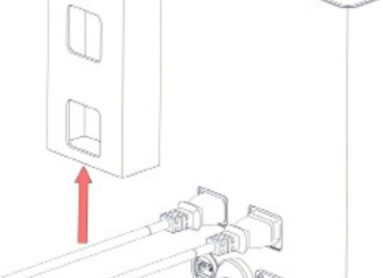Inovus support centre
Hardware setup
LapAR Pro Setup (1st Generation)

Welcome to the step-by-step assembly guide for the LapAR Pro. Whether you prefer step by step instructions or a video demonstration, this guide will walk you through the assembly process.
Before you begin, take a moment to review the package's contents and acquaint yourself with the included components. The following content has been crafted to provide you with all the insights required to transform individual parts into a functional and invaluable tool for honing your surgical skills.
Step-by-Step guide
Let's start assembling and enhancing your surgical skills, one step at a time.

Step 1
When opening your simulator it is recomended that you unpack all package contents and arrange them before starting construction.
Once you have done this, take the first part labelled AR20_BTM01 and lay it on a secure flat surface.

Step 2
Now take the following parts:
- 2x MA01
- 1x AR20_U02
- 2x WN14
- 2x M5B24
Using the image as a guide, pay close attention to the part orientation in this step or you will have to undo work at a later stage.

Step 3
Screw into place 2x MA01 using 2x M5B24 and 2x WN14
(Use the pin on part MA01 to find the correct position)

Step 4
Repeat the last two steps with the same parts on the front panel AR20_U01 as shown in the image.

Step 5
Take 4x AR20_M-BKT, position them in the keys provided.
In a practical sense this will need to be done one at a time with the simulator positioned on its side.

Step 6
Using 4x M5B24 screw each AR20_M-BKT into position on the base.
These parts are threaded for ease of assembly.

Step 7
At this stage the simulator should look exactly like the reference image.
If something appears to be incorrect, go back through the steps again.

Step 8
Locate the following parts:
- 1x AR20_TPB01
- 2x AR20_BKT
- 2x AR20_SK
- 6x M5B24
- 6x WN14
Placing the AR20_SK on to the top surface of the AR20_TPB01 ensure that the holes align correctly. You can now position the black AR20_BKT on top of the silicone skin, pushing three M5B24 through the holes.
Now move to the next step.

Step 9
Now attach 3x WN14 to the bolts coming through the bottom surface.
Repeat this process on the opposite side to complete the assembly.

Step 10
Remove the AR20_CAM from its packaging and place into position as shown.

Step 11
Take 2x M5B24 bolts and affix the AR20_CAM into position.
DO NOT plug-in at this stage.

Step 12
Take the sub-assembly from the last four steps and place it over the upright panel of the simulator as shown.

Step 13
Locate the following parts:
- 4x MA01
- 4x WN14
- 4x M5B24
Repeat the process from steps 2,3 & 4.
Do this on each corner so that a magnet is in place for the side panels to connect into.

Step 14
It is important to note that the simulator is capable of multiple platform positions.
When inserting AR20_TAB you will most commonly use the angled base for Augmented Reality applications.

Step 15
You will use the flat platform for LapPass® and any other non-AR tasks.
Enterprise users can use this for any tasks they like, including those where electro-surgical instruments are required.

Step 16
Snap into place both side panels and move on.

Step 17
Connect the USB micro into the back of the camera.

Step 18
Start the assembly of your portable trolley system by unscrewing the M8 bolts at the rear of chassis so that you have around 3-4mm of space between the head of the bolt and the chassis wall.
You can do this using the allen key provided.
Take the L shaped screen bracket and place it onto the M8 bolts as shown.

Step 19
Drop the bracket onto the bolts.

Step 20
Screw the bolts tight using the allen key provided.
Be careful not to over-tighten at this stage.

Step 21
Take the assembled monitor bracket and clamp it in position as shown.

Step 22
Screw the clamp until tight.

Step 23
Attach the monitor screen using the 4x M4 bolts provided.

Step 24
As shown in the image, plug in the IEC, HDMI & USB cables.

Step 25
Carefully thread the 3 wires we plugged in during the previous step up through the L shaped bracket and onto the monitor bracket.
Move to the next step.

Step 26
Position the wires as such and plug in to the appropriate socket.

Step 27
Plug the IEC connector into the back of the system.

Step 28
Plug the connector into the mains power.

Step 29
If a WIFI connection isn’t present, plug in the network cable provided with the system.

Step 30
Place your constructed simulator that you should have already assembled onto the top surface.

Step 31
Plug in the USB cable to the USB ports on the trolley system
Note: depending on the system you have purchased, USB port location may vary.

Step 32
Turn the system on using the power switch on the front. Once the computer has loaded up, select the LapARTM icon on the desktop and follow the instructions inside the software.
Assembly Video
View the assembly video for the LapAR Pro
Downloads
You can save the LapAR setup manual below. Or print this page for a hard copy version.
Was this article helpful?
We’re sorry to hear that.
Please can you give us some feedback to improve this page?
If you’d like a member of our support team to get back to you, please send a message to support@inovus.org